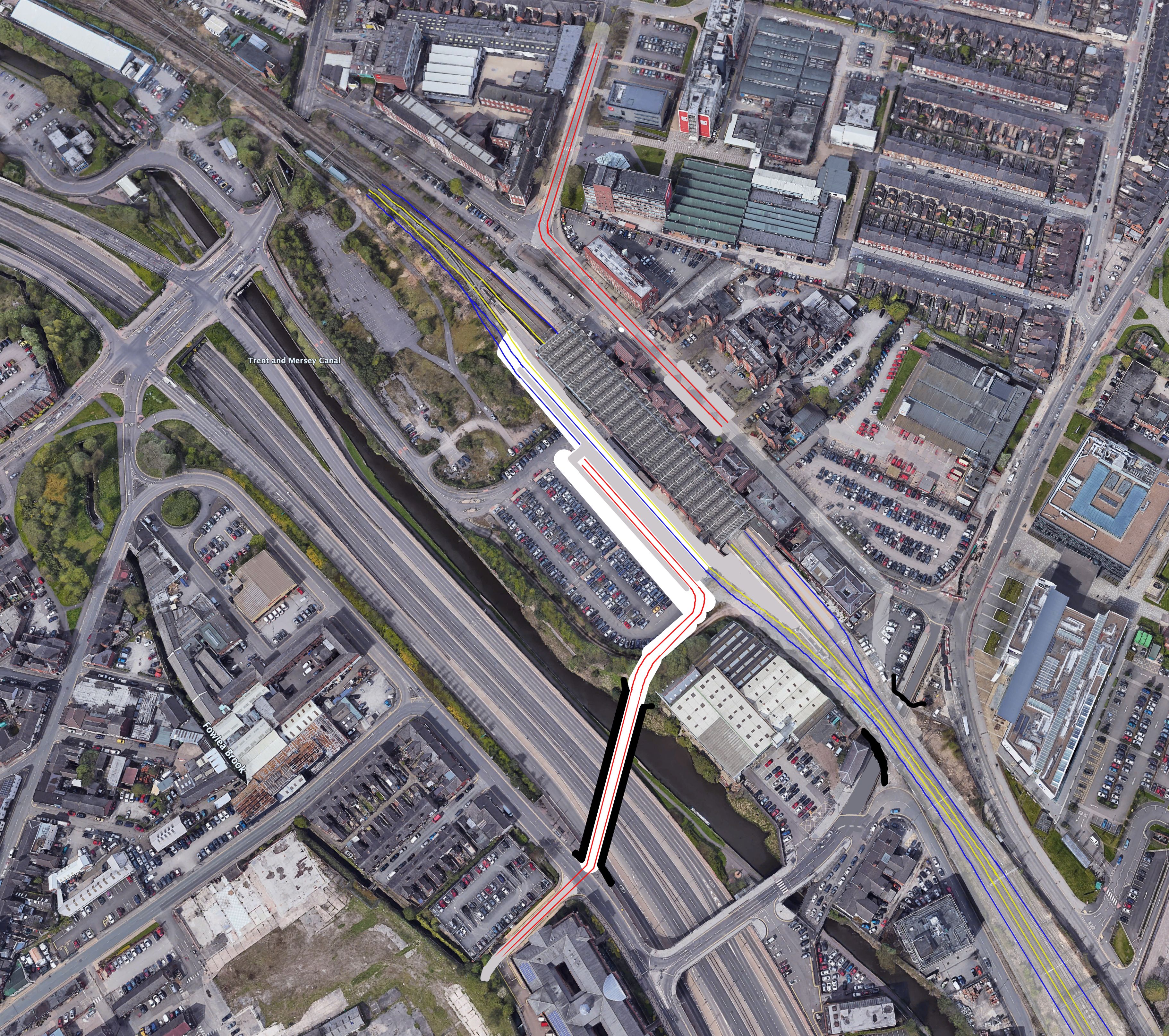Stoke Station
Stoke Central Station is appallingly small for a city of 350,000 people. Indeed, it may be the smallest station of any British city with more than 200,000 people. Despite much of the line previously being quadded, the station has just two through-platforms (plus a small bay platform on the up-line), testament to how much freight traffic used to pass through versus passenger traffic. By contrast, Stafford - a town of just 100,000 - boasts a full seven platforms with multiple passing lines (this is so excessive that only five are in use).
Stoke Station presents a significant limitation as running stopping services along the mainline is (and will continue to be) extremely difficult as they would conflict with fast intercity services. This will only get worse with the HS2 classic-compatible trains travelling to Macclesfield. Combined with the stopping services cutting through on the Crewe-Derby line, the demand for platform space puts a hard limit on the ability to operate urban rail and urban stopping services in Stoke as I have proposed.
To that end, a major expansion of Stoke Station is necessary. Quadding the track all the way in for four through-platforms, as well as providing a bay at either end, and tram stops serving Hanley and Newcastle-Under-Lyme.

Fortunately, Stoke Station has a large space of open land to the west, sandwiched between the station and the canal. The existing car park would mostly be lost, with a multi-storey (not shown) constructed to the north-west, offering more capacity with a smaller footprint. Although four lines previously ran through the station (two as passing lines), there is insufficient space to add additional platforms within the existing structure.
One option would be to simply demolish the roof and buildings on the western side, completely rebuilding everything other than platform one. This would be immensely expensive and disruptive to services on the mainline.
More effective would likely to be to accept the wasted space and turn platform 2 into an island platform, bringing the third and fourth lines into the car park. Other than some realignment works and installation of S&C, this leaves the existing platforms relatively intact. Platform 4 would be in the existing carpark, serving as a rail platform on one side and a tram-stop on the other. West-bound trams would depart for Newcastle and Keele. These would likely require a new bridge over the A500, since the proposed Goods Yard development would not permit access to the A52/Glebe Street bridge.
A north-bound tram stop servicing Hanley (and beyond) would be provided on Station Road, which would be closed to through-traffic and restricted to taxis and access. In theory it would be nice to simply tunnel under the station for a tram through-link, creating a significant hauptbahnhauf arrangement. However, as there are already significant spaces underneath the station the trams would have to dive impracticably deep. Those spaces do however offer provision for a vibrant pedestrian underpass with shops and traders connecting the tram stops, rail platforms and tying into surrounding developments such as the University and the Goods Yard.
Two bay platforms would be provided, one to the southern end by platform one and another to the north end by platform 4. The southern bay is especially important for teriminating trains coming from Leek, as they can reverse direction without blocking Platform 1 to through-traffic.
Widening the bridge to the south-east of the station to accommodate four lines would probably require closing Glebe Street to vehicle traffic because the road has to dip under the railway. The widened bridge is unlikely to leave adequate clearance for cars.
To be clear, this is not a cheap endeavour. Without any professional knowledge of such projects, it is easy to see the extension of Stoke Station costing £250m for the new rail platforms and realignment works (not including tram costs). Ultimately though, this is a long overdue investment in the economic and social infrastructure of Stoke on Trent. It simply isn’t practicable to run high-frequency urban and commuter rail services along the mainline, Leek line or Crewe-Derby line without additional platforms. As Stoke’s population grows, the roads become more congested and demand for public transit grows. Developing a capable rail hub is vital if Stoke is to avoid further economic and social decline. It is not practicable in the long run to promote investment in Hanley when access is almost entirely by car - and then via congested single-carriageway urban roads. Despite the collosal investment in the A50 and A500 through the 1990s, both these roads are already logjammed during peak hours and unable to support economic growth in Stoke.
Creating the provision for local urban rail and tram access not only creates that network for the wider Stoke community, but also creates an exciting urban hub, adding value to the £60m Goods Yard development and redevelopment around City Hall. This creates a greater-than-the-sum-of-its-parts regeneration zone.